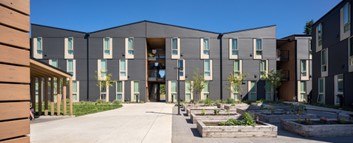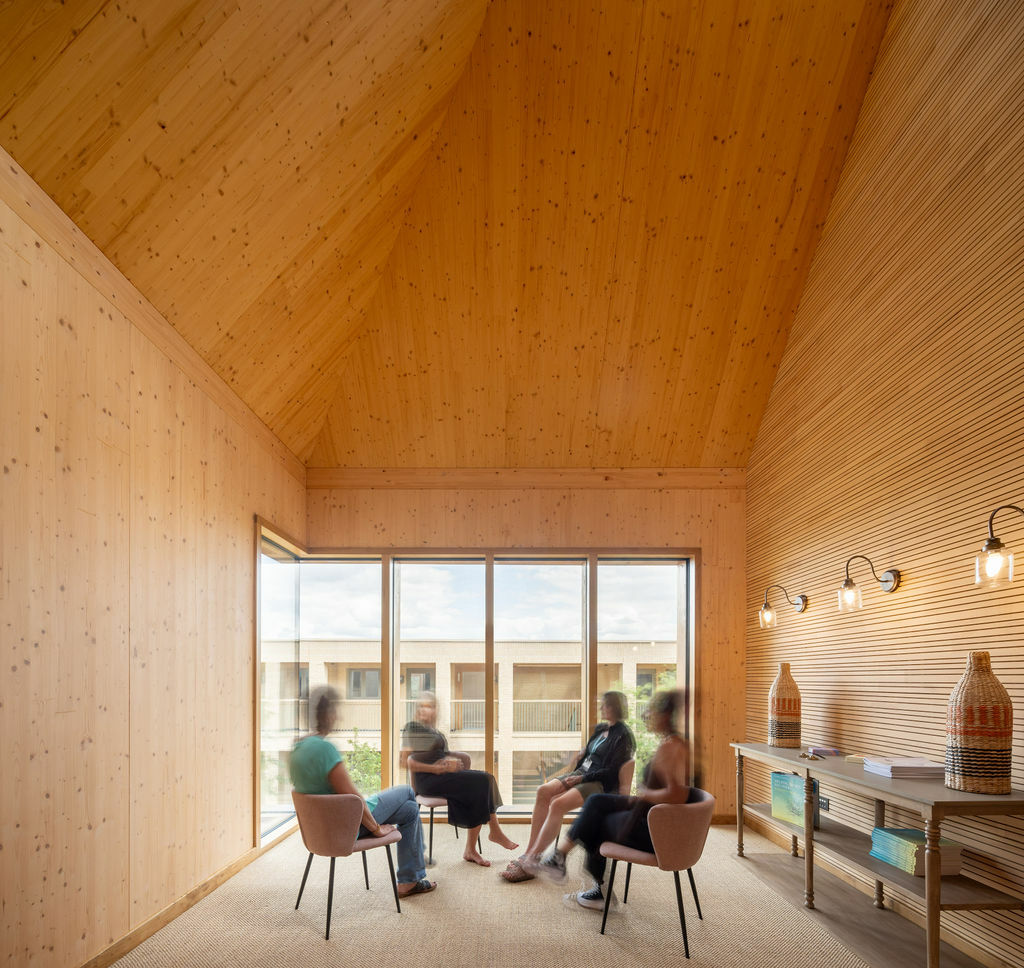Anna Martin
ESR7

Host university
B5 - Institute for Sociology, Centre for Social Sciences, Hungarian Academy of Sciences Centre of ExcellenceSupervising team
József Hegedüs (Supervisor) Adriana Diaconu (Co-Supervisor) Gerard van Bortel (Co-Supervisor)Secondments
Budapesti Módszertani Szociális Központ, Hungary Housing Europe, Belgium Ceraneo, CroatiaResearch project
ESR7 - Housing crisis and its impact on adequate housingAnna Martin has a background in environmental social science and holds a double degree from the Master Program in Environmental Science (EnvEuro) from the University of Copenhagen (Denmark) and SLU (Sweden). She completed her studies with a specialisation in Environmental Management to be able to move between science, policy and practice.
Originally from Hungary, she has lived and worked in Denmark, Sweden, France and in the USA. Her experiences with private foundations, consultancies and governmental authorities added to her strong interest in development projects based on specific societal (democratic, sustainability) issues.
Anna will be working on the research project “Housing crisis and its impact on adequate housing” (ESR7), based at the Institute for Sociology, Centre for Social Sciences, Hungarian Academy of Sciences Centre of Excellence (Budapest).
September, 11, 2023
May, 14, 2022
Housing crisis and its impact on adequate housing
In 2021 the European Parliament finally responded to the housing crisis, calling member states of the union to recognize adequate housing as a fundamental human right. Adequate and affordable housing in the different Member States of the European Union is inseparable from European and international politics. However, the success is heavily dependent on the attitude of Member States, on how much they are willing to use their discretion and develop a new standard of housing policies with a focus on social inclusion (with addressing both regional and social inequalities), economic effectiveness, and environmental protection.
Housing is a social need, as it is at the heart of our daily lives. It affects the longevity of our civilization. Member states must be willing to invest in social housing with the help of European Cohesion Funds (e.g., ERDG, ESF+, Just Transition Fund, or Next Generation EU) and beyond. The European Semester provides the Member States with a forum where they can discuss fiscal, policy, and economic challenges and transfer good practices from one country to another, overcoming institutional differences. There is a need to address the issues of housing affordability, lack of access to housing finance, increasing segregation, homelessness, and deteriorating housing situations. Marginalized societal values are requesting center stage during these critical times. Agency is often removed from vulnerable groups, and they cannot exercise their right to adequate housing (including the security of tenure, access to services and materials, facilities, and infrastructure, affordability, habitability, accessibility, location, and cultural appropriateness).
This research aims to investigate the housing crises in Europe both at the individual level and at the level of society. Including both the macro and the micro-level, it will be demonstrated how individual and structural factors are interlinked and contribute to housing issues together.
Sub-topics:
- The main causal mechanisms caused by the underlying and conflicting paradigms (”Enable Housing Market” / ”Housing for All”) (Hegedüs, 2021) will be examined in the context of two countries: Croatia and Hungary. Both countries were affected by the wealth-creating feature of housing as a commodity that has been reinforced over time, which inevitably made housing costs more expensive. Despite the optimistic expectations of the decades following the Second World War, social and territorial inequalities increased, and a new housing precariat emerged as the socio-economic position of the middle class became unstable. With a particularistic nature, the research will rehabilitate the ´juxtapositional approach´ (Kemeny and Lowe, 1998) and describe the contrast and similarities between the two countries.
- Housing affordability is a primary driver of precarity, affecting both upward and downward mobility. A growing number of middle-income people have difficulty affording adequate housing in Europe, facing safety concerns, as they can only access unhealthy, low-quality, energy-inefficient, or overcrowded housing options. Their situation has become fragile partly because of the liberalized labour market, or the system abandoned them due to the cuts in the welfare state. Meanwhile, the number of evicted and homeless people is also rising. The planned output of this research is to correct misinterpretations of the concept of the precariat and to explore the new meaning(s) of risk society. Also, to examine clashing vulnerabilities between marginalized people and increasingly downwardly mobile people from the middle classes (as they are competing for the same resources).
- The built environment profoundly impacts our mental, emotional, and physical well-being and promotes empowerment. This study explores the role of trauma-informed design in the supportive housing sector, where people often live with complex needs. In the form of a conceptual paper, the knowledge and expertise of academic and non-academic members of our society (particularly those in the housing and care sector) will be synthesized to explore the opportunities and challenges of implementing psychologically informed design principles. It is argued that considering these fundamental principles should be a crucial aspect of any effective social housing program, whether at the European, national, or local level. The results go beyond the boundaries of specific scientific disciplines, offering a convergence of different theoretical perspectives.
Hegedüs, J. (2021). Limits and Options for Affordable Housing Policies. Housing governance to support housing affordability. UNECE Regional Online Workshop.
Kemeny, J., and S. Lowe. (1998). “Schools of Comparative Housing Research: From Convergence to
Divergence.” Housing Studies 13 (2): 161–176. doi:10.1080/02673039883380.
Housing crisis and its impact on adequate housing - The new housing precariat in Denmark and Hungary
In 2021 the European Parliament finally responded to the housing crisis, calling member states of the union to recognize adequate housing as a fundamental human right. Adequate and affordable housing in the different Member States of the European Union is inseparable from European and international politics. However, the success is heavily dependent on the attitude of Member States, on how much they are willing to use their discretion and develop a new standard of housing policies with a focus on social inclusion (with addressing both regional and social inequalities), economic effectiveness, and environmental protection.
Housing is a social need, as it is at the heart of our daily lives. It affects the longevity of our civilization. Member states must be willing to invest in social housing with the help of European Cohesion Funds (e.g., ERDG, ESF+, Just Transition Fund, or Next Generation EU) and beyond. The European Semester provides the Member States with a forum where they can discuss fiscal, policy, and economic challenges and transfer good practices from one country to another, overcoming institutional differences. There is a need to address the issues of housing affordability, lack of access to housing finance, increasing segregation, homelessness, and deteriorating housing situations. Marginalized societal values are requesting center stage during these critical times. Agency (“the ability to act”)(Valentine, 2001, p.349) is often removed from vulnerable groups, and they cannot exercise their right to adequate housing (including the security of tenure, access to services and materials, facilities, and infrastructure, affordability, habitability, accessibility, location, and cultural appropriateness).
This research aims to investigate the housing crises in Europe both at the individual level and at the level of society. Including both the macro and the micro-level, it will be demonstrated how individual and structural factors are interlinked and contribute to housing issues together. The main causal mechanisms caused by the underlying and conflicting paradigms (”Enable Housing Market” / ”Housing for All”) (Hegedüs, 2021) will be examined in the context of two countries: Denmark and Hungary. Both countries were affected by the wealth-creating feature of housing as a commodity that has been reinforced over time, which inevitably made housing costs more expensive. Despite the optimistic expectations of the decades following the Second World War, social and territorial inequalities increased, and a new housing precariat emerged as the socio-economic position of the middle class became unstable.
With a particularistic nature, the research will rehabilitate the ´juxtapositional approach´ (Kemeny and Lowe, 1998) and describe the contrast between the two countries (e.g.: different political economies, social security systems, regime types). Also, a new framework will be developed, to differentiate marginalized groups (people in extreme poverty) from the precariat (low- and middle-income groups in precarious housing situations).
The research would employ a mixed research design to reach its objective. After desktop research, it will experiment with the role of action research in housing studies to nurture a transdisciplinary understanding. There is a hypothesis that action research would be able to overcome the split between local initiatives at the action level and their societal potentials on the macro level, and it would be able to connect the pillars (community participation/policy and financing/design, planning and building) of the RE-DWELL ITN research project. Results of the research will enable the researcher to have an intelligent estimate of the forces that caused the housing crises and provide the reader with theoretically informed and empirically verified knowledge about the best practices in affordable housing options and policy solutions.
In short, this study will highlight the brutal consequences of the shift from a general welfare approach (where housing is a societal pillar) to a neoliberal housing market and provide both: a systematic overview and personal stories to show the full spectrum of issues of the housing crises in Europe.
Hegedüs, J. (2021). Limits and Options for Affordable Housing Policies. Housing governance to support housing affordability. UNECE Regional Online Workshop.
Kemeny, J., and S. Lowe. (1998). “Schools of Comparative Housing Research: From Convergence to
Divergence.” Housing Studies 13 (2): 161–176. doi:10.1080/02673039883380.
Valentine G. (2001). Social Geographies: Space and Society.
Prentice Hall: London.
Reference documents
Reference documents

Social Sustainability in post-communist countries
Posted on 18-09-2023
Secondments
Read more ->
Activism and Philanthropy: A Call for Collaboration in Addressing Housing Affordability and Social Challenges in Europe
Posted on 13-09-2023
Reflections
Read more ->
Clashing Vulnerabilities
Posted on 13-02-2023
Secondments
Read more ->
The New Housing Precariat in Europe
Posted on 26-12-2022
Secondments
Read more ->
The Elwood Project, Vancouver, Washington
Created on 25-01-2024

Mason Place Apartments
Created on 11-12-2023

Hope Street
Created on 23-05-2025
Critical Utopian Action Research
Deliberative Democracy
Energy Communities
Housing Regime
Precariat
Trauma Informed Design
Area: Community participation
Created on 05-07-2022
Read more ->Area: Community participation
Created on 19-06-2024
Read more ->Area: Design, planning and building
Created on 14-10-2024
Read more ->Area: Policy and financing
Created on 24-02-2022
Read more ->Area: Policy and financing
Created on 21-03-2024
Read more ->Area: Design, planning and building
Created on 10-12-2023
Read more ->Martin, A. (2023, June). Clashing Vulnerabilities for the right to adequate housing. Marginalized groups vs. middle-income groups in a precarious housing situation. In Clashing Vulnerabilities, Uppsala, Sweden.
Posted on 06-01-2026
Conference
Read more ->